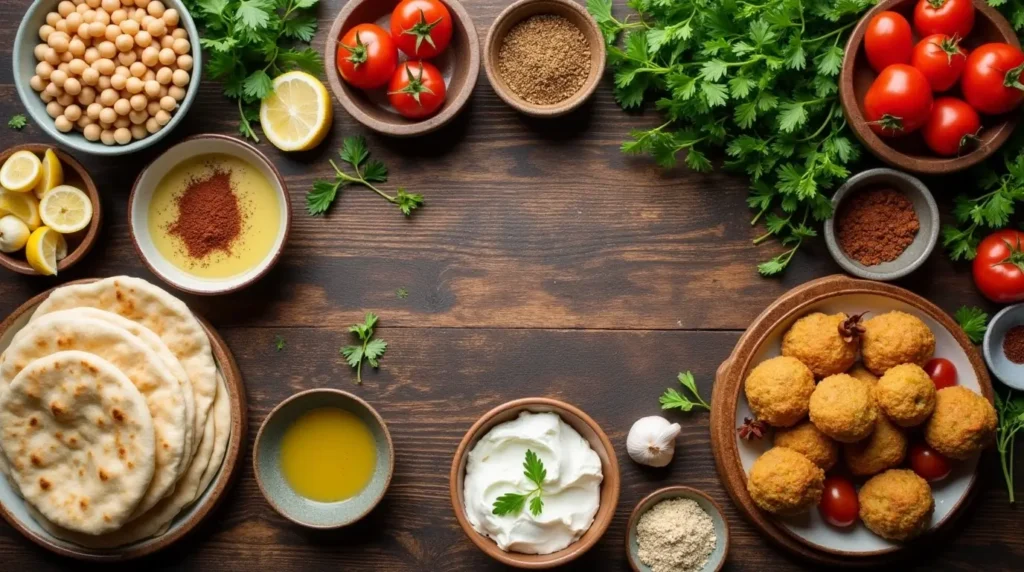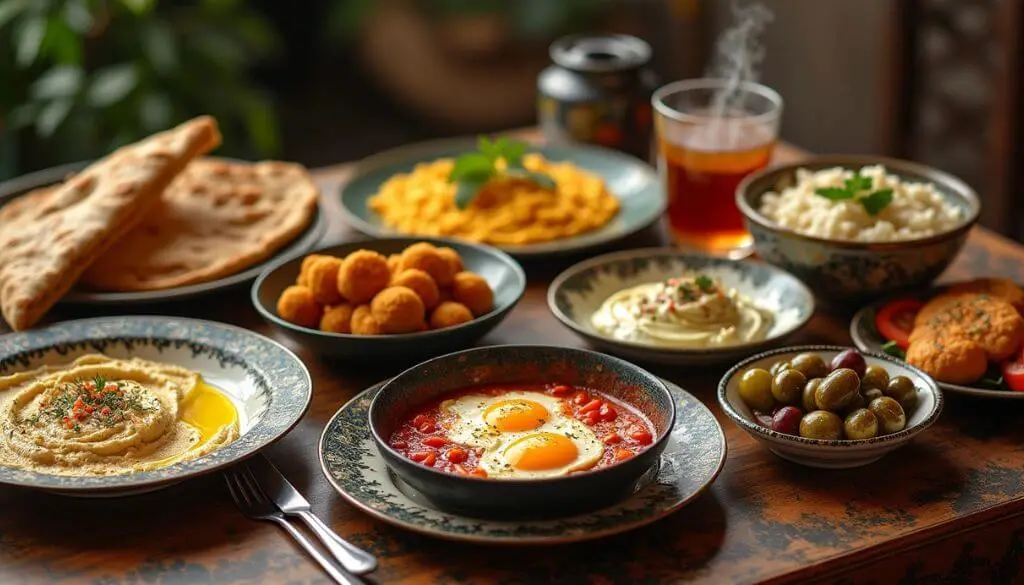1. Introduction
Traditional Arab morning meals unite Middle Eastern tastes with fresh components and age-old culinary traditions. From the Middle East to North Africa, multiple communities prepare morning meals in a spectrum of rich to light varieties. Two famous meals in the Arab world include tasty Egyptian Ful Medames alongside North African Shakshuka, which combine delicious flavors with traditional authenticity.
Table of Contents
Metro and coastal regions in the Middle East use olive oil together with fresh herbs eggs and legumes to prepare delightful and nourishing culinary creations. Daily breakfasts consumed at street stalls and prepared at home consist of baking products cheeses and olives and spicy seasonings served warm.
The following guide presents five iconic Arab breakfast items that should not be missed for their delightful tastes together with their historical significance and health advantages. The dishes mentioned here represent excellent choices for starting your morning in Arab cooking tradition regardless of whether you are breaking into the cuisine for the first time or seeking new breakfast ideas.

2. Key Benefits
The breakfast meals of Arab cuisine combine delicious taste with numerous health advantages for the body. Traditional Arab recipes contain healthy whole ingredients consisting of fresh elements like olive oil as well as legumes and eggs together with dairy products that bring essential vitamins and minerals to the table.
These meals supply the body with both energy and satisfaction to serve as a morning foundation. Due to their protein content with fiber and healthy fats these foods provide essential nutrients for digestion while helping you stay full throughout the morning. The combination of Ful Medames alongside Hummus provides protein benefits then Labneh and Cheese Platters deliver both gut health benefits and calcium content.
The Arabs practice traditional family dining through sharing homemade foods at breakfast time. Both light dishes based on Labneh and olives or healthier choices such as Shakshuka provide options for different eating preferences with natural Arab food tastes that deliver nutritional benefits.
3. Ingredients
Each Arab breakfast dish has its own unique set of ingredients, but many share common staples that define the region’s flavors. Here are the essential ingredients used in the top five dishes:
- Ful Medames: Cooked fava beans, garlic, lemon juice, cumin, olive oil, and fresh parsley.
- Shakshuka: Eggs, tomatoes, bell peppers, garlic, onions, and spices like cumin and paprika.
- Manakish: Flatbread topped with za’atar (a blend of thyme, sesame, and sumac) or cheese.
- Labneh with Olive Oil and Za’atar: Strained yogurt, extra virgin olive oil, za’atar, and fresh mint.
- Hummus with Pita Bread: Chickpeas, tahini, lemon juice, garlic, and olive oil.

Arab cooking traditions thrive because of these specific ingredients that give rise to nutritious and flavorful foods. The health benefits of breakfast meals increase because they feature fresh spices together with aromatic herbs and top-quality olive oil.
4. Instructions
The following guide explains preparation steps for cooking tasty Arab breakfast dishes:
Ful Medames
- Rinse and drain cooked fava beans, then heat them in a pan with a little water.
- Mash lightly and mix with garlic, lemon juice, cumin, and olive oil.
- Garnish with fresh parsley and serve with warm pita bread.
Shakshuka
- Sauté onions, garlic, and bell peppers in olive oil until soft.
- Add tomatoes, cumin, paprika, salt, and pepper, then simmer.
- Make small wells in the sauce and crack eggs into them. Cover and cook until set.
Manakish
- Mix za’atar with olive oil and spread on flatbread.
- Bake at 375°F (190°C) until golden brown.
Labneh with Olive Oil and Za’atar
- Spread labneh on a plate, drizzle with olive oil, and sprinkle with za’atar.
Hummus with Pita Bread
- Blend chickpeas, tahini, lemon juice, garlic, and olive oil until smooth.
- Serve with pita bread and a drizzle of olive oil.
5. Pro Tips and Variations
- Ful Medames: For extra flavor, add a drizzle of tahini or a sprinkle of chili flakes. Serve with boiled eggs for added protein.
- Shakshuka: Customize by adding feta cheese, spinach, or spicy harissa for a bolder taste. Cook eggs to your preferred doneness.
- Manakish: Experiment with toppings like cheese, ground meat, or a mix of za’atar and honey for a sweet-savory twist.
- Labneh with Olive Oil and Za’atar: If you like a tangy taste, mix in a bit of lemon zest or serve with sliced cucumbers and tomatoes.
- Hummus with Pita Bread: Add a smoky touch by blending in roasted red peppers or a bit of cumin.
6. Serving Suggestions
Arab breakfast dishes are meant to be enjoyed with various sides and accompaniments, offering a complete and satisfying meal. Here are some ideas to elevate your breakfast experience:
- Ful Medames: Serve with warm pita bread, olives, and sliced tomatoes for a fresh, balanced meal. A side of pickles adds a tangy contrast.
- Shakshuka: Pair with crispy bread or baguette to scoop up the sauce. A side of Greek yogurt or feta cheese can add a creamy texture.
- Manakish: These can be enjoyed alone or with a side of labneh, fresh cucumber slices, or hummus. A light fruit salad can add sweetness.
- Labneh with Olive Oil and Za’atar: Best served with flatbread and sliced vegetables such as cucumbers and tomatoes. A refreshing side of olives complements the creamy texture.
- Hummus with Pita Bread: Pair with tabbouleh (a parsley salad) or grilled vegetables for added nutrition and texture.
8. FAQs
Q1: Can I make these Arab breakfast dishes ahead of time?
Yes, many Arab breakfast dishes can be prepared in advance. Ful Medames and Hummus can be stored in the fridge for a few days. Shakshuka is best made fresh, but you can prep the sauce the night before and simply add the eggs in the morning. Manakish can also be prepared ahead of time and reheated in the oven.
Q2: Are these breakfast dishes suitable for vegetarians or vegans?
Yes, most of these dishes are vegetarian, and many are also vegan. Ful Medames, Manakish, and Hummus are naturally plant-based. Shakshuka can be made vegan by using plant-based eggs or skipping the eggs altogether. Labneh is dairy-based, so you can replace it with a vegan yogurt alternative if necessary.
Q3: Can I make these dishes spicy?
Absolutely! You can adjust the level of heat in Shakshuka by adding more chili peppers or harissa. For Ful Medames, a touch of chili flakes or hot sauce can add a nice kick. Experiment with spices to match your heat tolerance.
7. Conclusion
The dietary ritual of Arab breakfast provides more than sustenance since it represents both flavors and cultural heritage as well as ancestral customs. Every dish between Ful Medames and Shakshuka carries distinct Arab world flavors by displaying fresh ingredients along with intense spices. These breakfast options are not only delicious but also nutritious, providing energy to start the day right.
You should start with these top five dishes if you want to either experience exotic cuisine or introduce Middle Eastern flavors to your meals. The dishes are simple to create and adjustable but remain authentic to their original cultures.
Did you Try this Recipe?
There are no reviews yet. Be the first one to write one.

